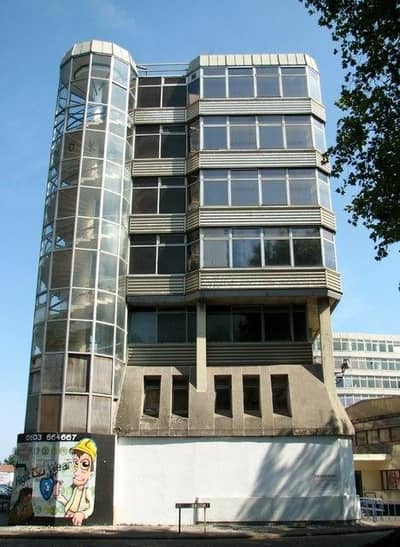Description of Sovereign House
Sovereign House was the headquarters of the HMSO (Her Majesty’s Stationery Office) between 1968 and 1996. Sovereign House itself was at the Anglia Square shopping precinct and was a very large brutalist office block that employed around 800 people at its peak.
Though it might surprise to know that even though Sovereign House was specifically built for the HMSO, they did not own the building and in fact leased it from the owners on a 40-year lease, paying £97,000 per year in rent. Sovereign House has been abandoned since at least the early 2000s and is in a terrible state of disrepair and will almost certainly never be occupied again.
The design of Sovereign House

Image © Evelyn Simak 2018 (CC-BY 2.0)
The design of Sovereign House is a brutalist one of glass and concrete with three wings and two iconic spiral stairways, surrounded with windows. Even though Sovereign House is not very tall, it looks over the St. Augustine area of Norwich, almost oppressively.
What did the HMSO do?
The HMSO was involved in the publication of official government documents and associated copyrights, including;
• Documents related to statutory instruments and laws
• Girocheque’s
• Government Reports
• Passports
• The Highway Code
• The London Gazette
• Yellow Pages directories
• And many more. Until 1980, The HMSO provided free Stationery supplies to the departments of the government and to parliament.
Construction of Sovereign House (1966 to 1968)
Construction work on Sovereign House would begin in 1966, with the building work being completed around two years later in 1968. After Sovereign House was built, workers would migrate from London with up to 120 employees moving into the city per month. They would then move paperwork to Sovereign House every Saturday, along with computer equipment.
Sovereign House in its Prime
After opening, Sovereign House would be an extremely busy environment with over 800 employees who often worked in open planned office spaces and who had plenty of activities to do around the bar area. As the headquarters, Sovereign House was in charge of core operations of the HMSO. By the mid-1970s, extra space was needed at the building but as plans for an expansion to Sovereign House on the other side of the ring road were rejected St Crispin’s House was built instead.
The Decline and closure of Sovereign House
The events that saw the closure of Sovereign House lead back to the early 1980s when budget cuts to the funding of the HMSO from the organization having to act more like a profit-making business would see a massive decrease in the amount of support staff that worked between the two HMSO headquarters (Sovereign House and St Crispin’s house).
Major design flaws would make Sovereign House too expensive to maintain by about 1993, which meant that it missed out on the refurbishment that St Crispin’s house got in the mid-1990s. They considered sovereign House at the time as being “not fit for purpose” which would lead to its closure in 1996.
The Dangerous Decay of Sovereign House

Image © Evelyn Simak 2020 (CC-BY 2.0)
HMSO moved out of Sovereign House in 1996 with the Cabinet office taking over the lease later that same year. Looking through some of the related documents, it becomes obvious that the poor maintenance of Sovereign House likely started years before the HMSO moved out. When the Cabinet office took over the lease, there was an estimated £1 million worth of damage to the building.
The hope was that the landlord would sell Sovereign House so that the government could take advantage of the terms of their lease in order to get 50% of the money from that sale, but that would never happen.
Even though the Cabinet office should have been responsible for the building until 2011, but the utterly awful condition that Sovereign House was in by the early 2010s would show that very little in the way of maintenance was done in those preceding years. The decay was not only from a lack of maintenance but also from man-made damage caused by vandalism and police training exercises.
In September 2014, someone working at the building posted a response to a thread on the popular Urban exploration forum; 28 Days Later. Telling people they needed to be careful of the asbestos near the canteen area and to avoid the basement plant room because of the “unstable fire suppression system”.
In 2015, an urban explorer made a trip to Sovereign House and took a bunch of pictures. The pictures he took of the roof are of most concern as it reveals the roof is in dreadful condition with massive cracks running across much of the surface which are so big that plants are growing within the gaps left by the cracks. This is terrible news for Sovereign House, as those cracks allow rain to enter the interior.
In late 2018, planning permission was granted in order to redevelop the Anglia Square site, which included plans to demolish Sovereign House but as of July 2019, it is still awaiting the outcome of an inquiry which was launched because of the high number of complaints in relation to the planned 20 story tower.
The Future of Sovereign House
To be blatantly honest, there is no future for Sovereign House as the building would be uneconomical to repair it will never be occupied again. Even if a company could overcome the ugliness of the office block. For Sovereign House, the only choice is between demolition or just leaving the building in place to rot away and eventually collapse.
